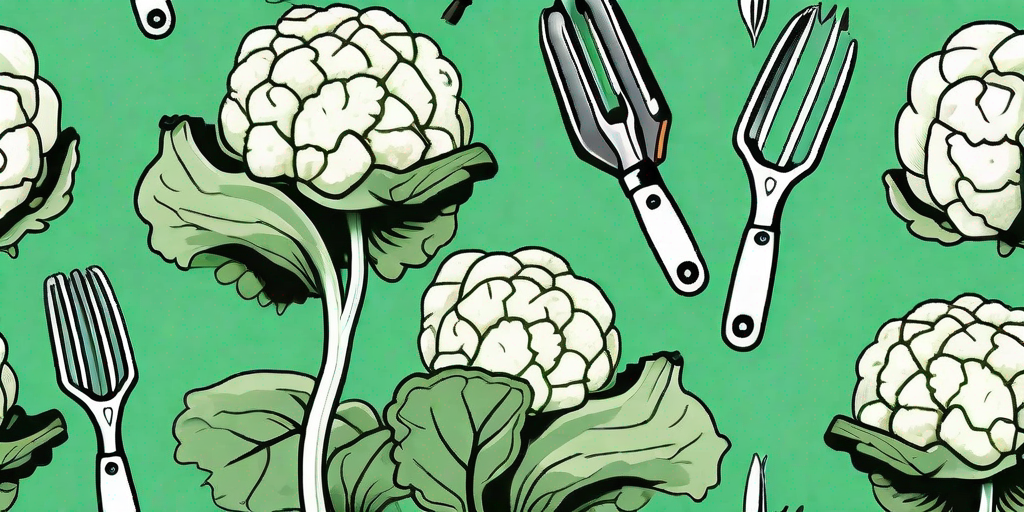
Welcome to the world of cauliflower harvesting! This isn't your average gardening task, oh no. This is a task that requires precision, patience, and a pinch of humor. After all, who knew that these little white clouds of veggie goodness could be so demanding? But don't worry, we've got you covered with all the tips and tricks you need to ensure your cauliflower harvest is nothing short of perfect. So, let's dive in!
Understanding the Cauliflower Plant
Before we get our hands dirty, let's take a moment to appreciate the cauliflower plant. It's not just a pretty face, it's a complex organism with its own set of needs and wants. Understanding these will help you to time your harvest perfectly.
The cauliflower plant is a member of the Brassica family, which also includes broccoli, cabbage, and kale. It's a cool-season crop, which means it prefers to grow in cooler temperatures. This is important to remember when planning your harvest. Too hot, and your cauliflower could bolt, leaving you with a bitter taste in your mouth (literally!).
The Life Cycle of a Cauliflower Plant
The life cycle of a cauliflower plant can be broken down into three main stages: germination, vegetative growth, and reproductive growth. Germination is when the seed sprouts and begins to grow. Vegetative growth is when the plant develops its leaves and stems. Reproductive growth is when the plant produces its flower head (the part we eat).
Each of these stages has its own set of needs. For example, during germination, the plant needs plenty of water. During vegetative growth, it needs plenty of sunlight. And during reproductive growth, it needs cooler temperatures. Understanding these needs will help you to provide the best care for your cauliflower plants, and ultimately, to time your harvest perfectly.
When to Harvest Cauliflower
Now that we understand the cauliflower plant a little better, let's talk about when to harvest. Timing is everything when it comes to cauliflower harvesting. Harvest too early, and you'll end up with small, underdeveloped heads. Harvest too late, and your cauliflower could become over-mature and bitter. But don't worry, we've got some tips to help you hit that sweet spot.
Generally, cauliflower is ready to harvest when the heads are compact, firm, and white. They should be about 6-8 inches in diameter. If the heads start to separate and the florets begin to show, this is a sign that the cauliflower is over-mature and should be harvested immediately.
Checking the Heads
One of the best ways to determine if your cauliflower is ready to harvest is to check the heads. This is where the magic happens, folks. The heads should be compact, firm, and white. If they're loose and starting to turn yellow, this is a sign that they're over-mature.
When checking the heads, be sure to look at the florets. These are the small, flower-like parts of the head. If they're tight and close together, this is a good sign. If they're starting to separate and show, this is a sign that the cauliflower is over-mature.
Feeling the Heads
Another way to determine if your cauliflower is ready to harvest is to feel the heads. Yes, you heard right. Get up close and personal with your cauliflower. The heads should feel firm to the touch. If they're soft or squishy, this is a sign that they're not ready to harvest.
When feeling the heads, be sure to check the stem as well. The stem should be strong and sturdy. If it's weak or floppy, this is a sign that the cauliflower is not ready to harvest.
How to Harvest Cauliflower
So, you've determined that your cauliflower is ready to harvest. Now what? Well, it's time to get your hands dirty. But don't worry, we've got some tips to make the process as smooth as possible.
First, you'll need a sharp knife. This is not the time to skimp on quality. A dull knife could damage the plant and make the harvest more difficult. Once you have your knife, simply cut the head off the plant, leaving a few leaves attached to protect the head.
Handling the Heads
Once you've cut the head off the plant, it's important to handle it with care. Remember, this is the fruit of your labor (literally!). The heads should be handled gently to avoid damaging the florets. They should also be kept cool to prevent them from wilting.
After harvesting, the heads can be stored in the refrigerator for up to a week. If you're not planning to eat them right away, you can also freeze them for later use. Just be sure to blanch them first to preserve their color and flavor.
FAQs
What if my cauliflower heads are small?
Small heads can be a sign of several things. It could be that the plant didn't get enough sunlight, water, or nutrients. It could also be that the temperatures were too high. If your heads are consistently small, you may want to consider adjusting your care routine.
What if my cauliflower heads are yellow?
Yellow heads are a sign of over-maturity. This means that the cauliflower was harvested too late. To prevent this, be sure to check your cauliflower regularly and harvest it as soon as it's ready.
Can I eat the leaves of the cauliflower plant?
Absolutely! The leaves of the cauliflower plant are edible and can be used in a variety of dishes. They have a slightly bitter taste, similar to kale or collard greens.
Conclusion
And there you have it, folks! Everything you need to know about cauliflower harvesting. Remember, the key to a successful harvest is understanding the needs of the plant and timing your harvest perfectly. With these tips and tricks, you'll be a cauliflower harvesting pro in no time. Happy gardening!











